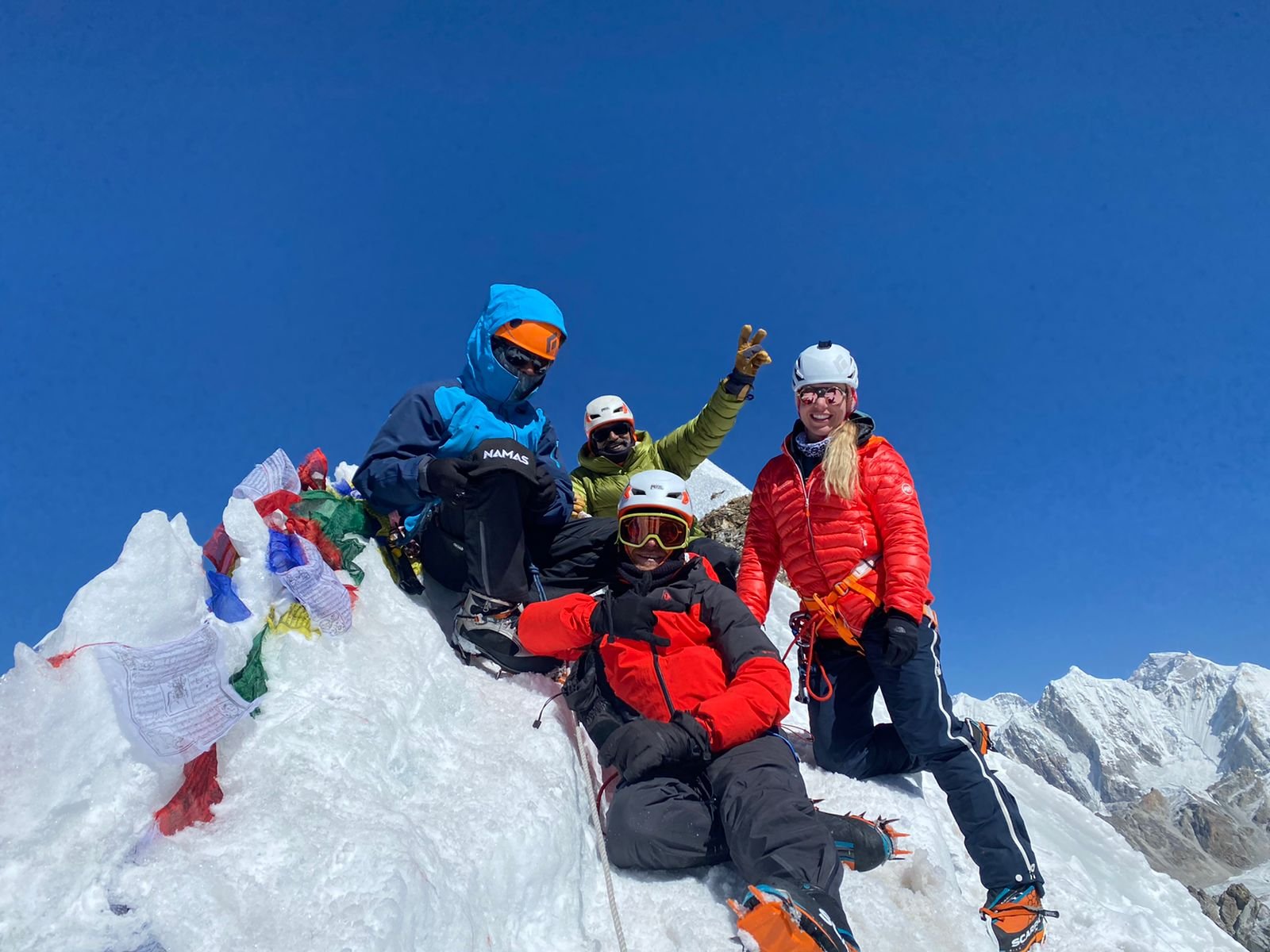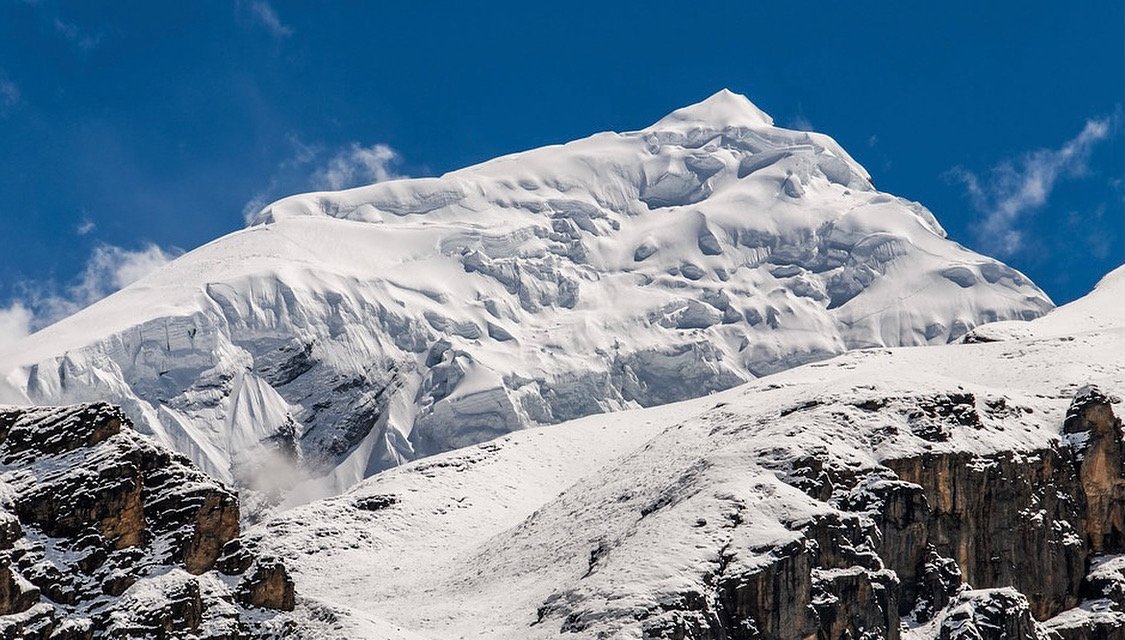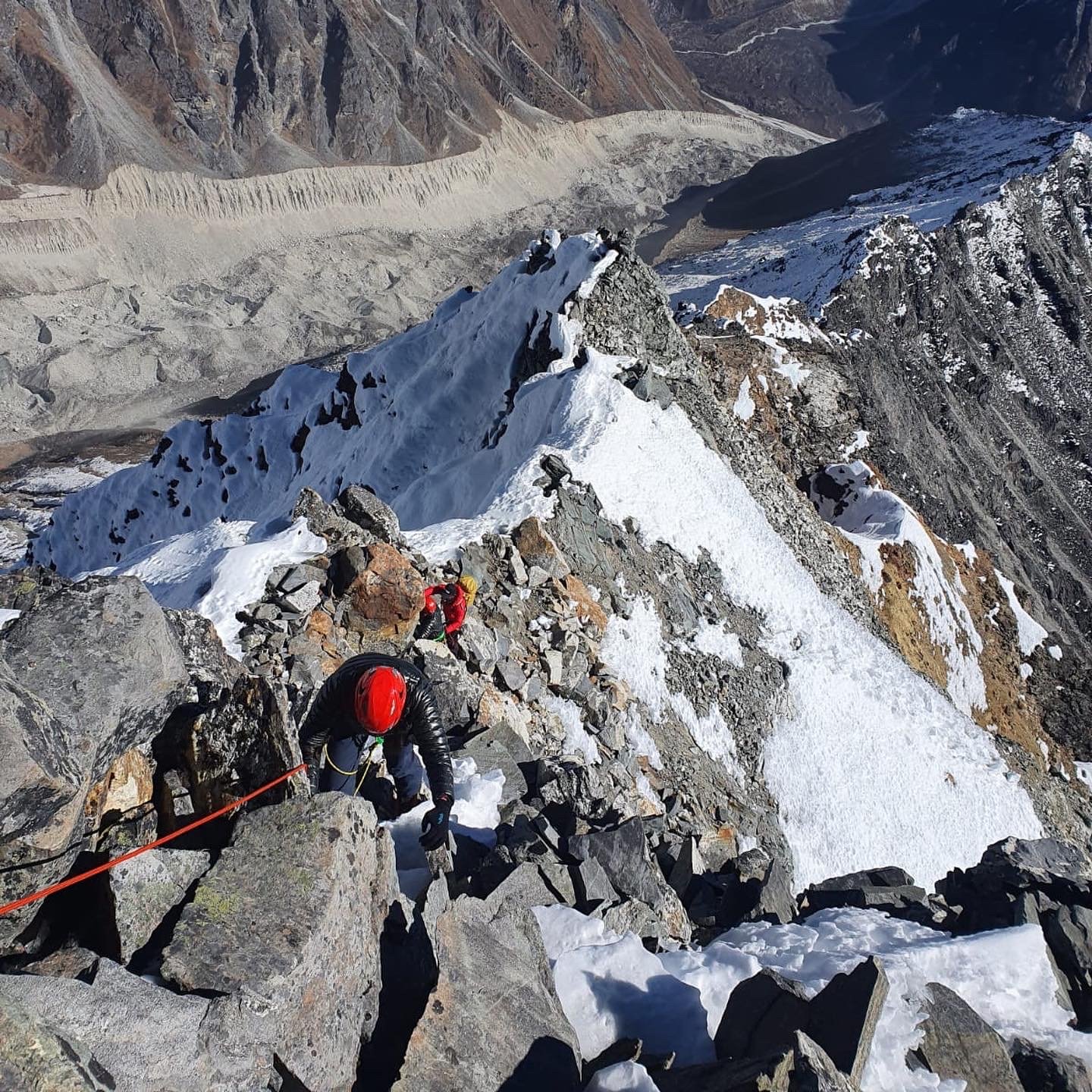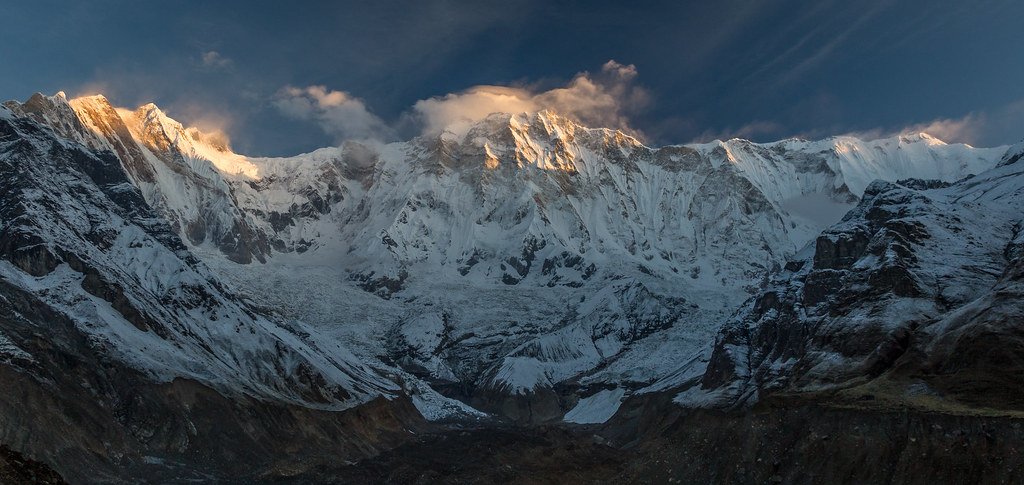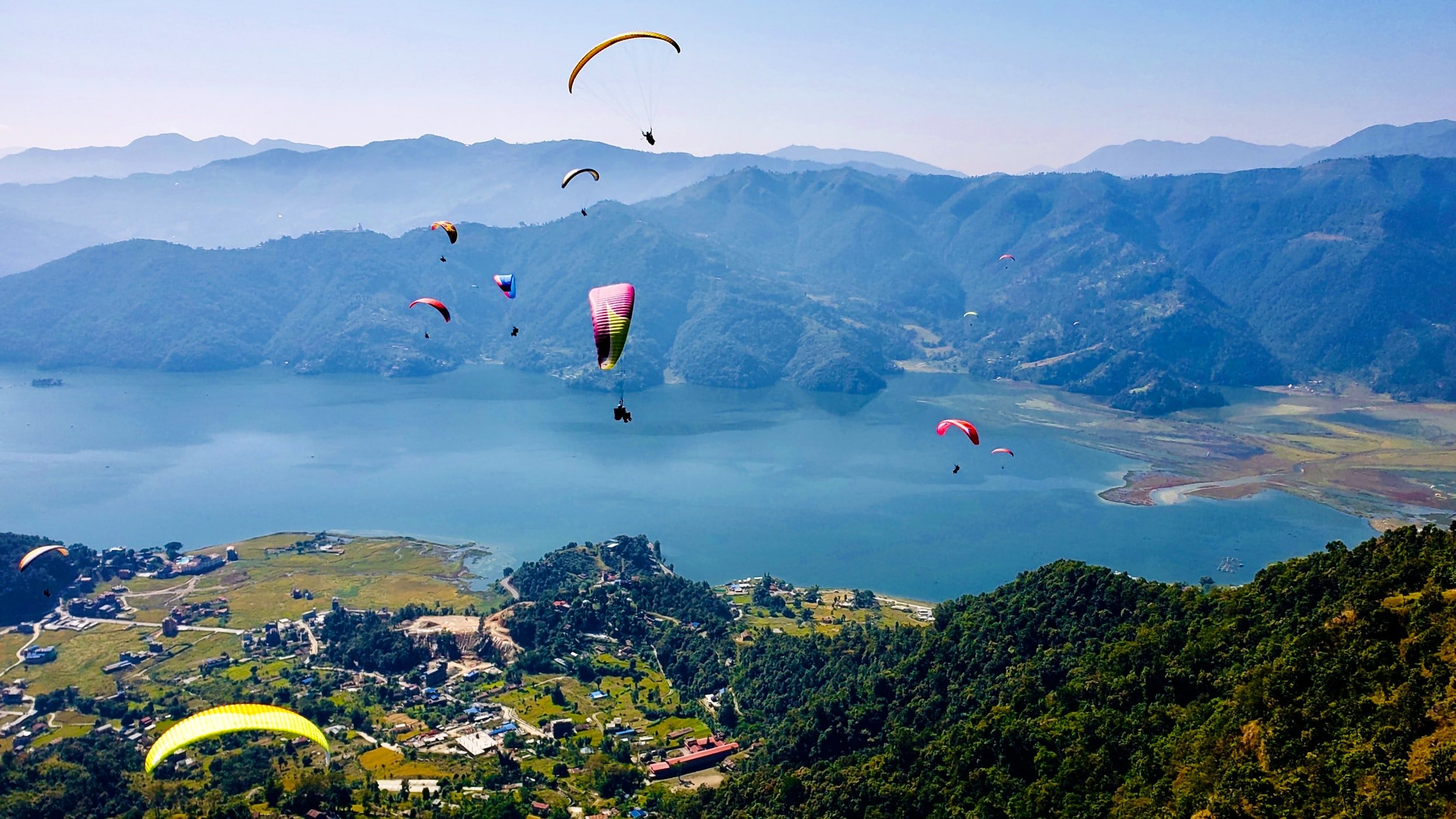Khumbu Three Peak Expedition vs. Annapurna Three Peak Expedition: A Comprehensive Comparison
Khumbu Three Peak vs. Annapurna Three Peak Expedition: A Comprehensive Comparison
Introduction
If you're exploring your next mountaineering adventure and want to challenge yourself with a once-in-a-lifetime adventure climbing 6,000 meters in the Himalayas, we present two exciting triple summit expeditions: the Annapurna Three Peak Expedition and the Khumbu Three Peak Expedition challenge. These expeditions stand out for their unique challenges and breathtaking landscapes, serving as a pure test of endurance and offering thrilling summit adventures amidst stunning beauty. Both involve summiting three significant peaks, providing an unparalleled experience for climbers. This article delves into a detailed comparison to help you choose the expedition that best aligns with your aspirations and capabilities.
Overview of the Expeditions
Khumbu Three Peak Expedition
Location: Khumbu (Everest), and Mera region. Eastern Nepal
Peaks Summited:
Mera Peak: 6,476 meter (21,246 feet)
Island Peak (Imja Tse): 6,189 meters (20,305 feet)
Lobuche East Peak: 6,119 meters (20,075 feet)
Duration: 30 days
Highlights: Iconic views of Everest, vibrant Sherpa culture, famous trekking routes
Annapurna Three Peak Expedition
Location: Annapurna Region, Central Nepal
Peaks Summited:
Chulu West: 6,419M meters (20,173 feet)
Chulu East: 6584 meters (21,601 feet)
Chulu Far East: 6,059 meters (19,878 feet)
Duration: 26 days
Highlights: Less crowded trails, diverse ecosystems, panoramic views of the Annapurna massif
Scenery and Terrain
Annapurna Region
Diverse Landscapes: From subtropical forests to alpine meadows and high-altitude deserts
Less Crowded Trails: Offers a more solitary and serene experience, unique cultural expereinces
Unique Features: Annapurna Sanctuary and massif 8000M - 7000M peaks, deep gorges, and terraced farmlands
Khumbu Region
Eveest, Lhotse Sharr seen from Everest trail.
Iconic Landscapes: Home to Everest, the world's highest peak
Busier Trails: Popular among trekkers worldwide, especially during peak seasons
Unique Features: Sagarmatha National Park, Khumbu Glacier, and the famous Everest Base Camp trail, to world highest peaks. Everest, Lhotse, Cho-Oyu etc
If you prefer solitude and diverse ecosystems, Annapurna might appeal more. For iconic mountain vistas and bustling trails, Khumbu is ideal.
Cultural Experiences
Annapurna Region
Ethnic Communities: Gurung and Magar villages
Cultural Highlights: Traditional farming practices, local festivals, and handicrafts
Monasteries and Temples: Bragha Iconic Monastery, Muktinath Temple (Mustang)
Braga Monaster, Manag region.
Khumbu Region
Ethnic Communities: Sherpa heartland
Cultural Highlights: Visit Tengboche Monastery, experience Sherpa hospitality
Monasteries and Temples: Tengboche Monastery
Tenboche Monastery, Everest region.
The Khumbu region offers a deep dive into Sherpa culture, while Annapurna provides a blend of different ethnic experiences.
Difficulty and Technical Requirements
Annapurna Three Peak Expedition
Technical Climbing: Chulu East and West Peak requires moderate technical skills, including ice and rock climbing. Chulu Far East peak requires is a lesser technical approach to mostly being high altitude trekking peak.
Physical Demands: High level of fitness required due to challenging terrains and higher altitudes
Preparation Needed: Prior high-altitude trekking and some climbing experience are essential
Khumbu Three Peak Expedition
Technical Climbing: Island Peak and Lobuche East require moderate technical skills; Mera Peak is less technical
Physical Demands: Demanding and must be fit for several days of climb and trek
Preparation Needed: Good physical condition and some basic climbing experience recommended
Annapurna's expedition is generally considered more challenging due to technical requirements, making it suitable for experienced climbers.
Best Time to Trek
Annapurna Region
Spring (March to May): Blooming rhododendrons, moderate temperatures
Autumn (September to November): Clear skies, ideal for mountain views
Winter: Less favorable due to harsh weather and trail conditions
Khumbu Region
Spring (March to May): Busy season, pleasant weather
Autumn (September to November): Most popular, excellent visibility
Winter: Possible but very cold; suitable for those who can endure low temperatures
Monsoon: Not recommended due to heavy rains and cloud cover
Both regions share similar optimal trekking seasons, with spring and autumn being the most favorable.
Logistics and Accessibility
Annapurna Three Peak Expedition
Starting Point: Kathmandu to Besisahar via jeep and off road to Humde
Transportation: Road transport to trailheads; fewer flights involved
Accommodation: Combination of teahouses and camping
Permits Required:
Annapurna Conservation Area Permit (ACAP)
Trekkers' Information Management System (TIMS) card
Climbing permits for each peak
Khumbu Three Peak Expedition
Starting Point: Lukla, reached by a flight from Ramechap
Transportation: Flight to Lukla; trekking from there
Accommodation: Well-established teahouses along the trail
Permits Required:
Sagarmatha National Park Entry Permit
Climbing permits for each peak
Khumbu is more famous for most traveller. Weather can cause delays to Lukla flights. Annapurna offers more flexibility with transportation.
Cost Considerations
All inclusive cost with Namas Adventure team
Safety Measures
Annapurna Region
Altitude Risks: Higher peaks may increase the risk of altitude sickness
Trail Conditions: Less crowded trails mean fewer immediate assistance options
Rescue Operations: Available but may take longer than Khumbu region
Khumbu Region
Altitude Risks: Still significant but with more established acclimatization protocols
Trail Conditions: Busy trails mean help is often nearby
Rescue Operations: More efficient due to better infrastructure and frequent helicopter services
Both expeditions require comprehensive safety measures, but Khumbu benefits from better-established rescue operations.
Who Should Choose Which Expedition?
Choose Annapurna If:
You prefer less crowded trails and a more solitary experience
You're looking for a challenging expedition with higher technical demands and mix of alpine and fixed line climbing
You're interested in diverse landscapes and ecosystems
Annapurna massif. Annapurna region.
Choose Khumbu If:
You want to experience iconic views of Everest and surrounding peaks
You're interested in Sherpa culture and well-established trekking routes
You prefer slightly less technical climbs
You require better infrastructure and amenities
Gokyo Ri. Everest region.
Your choice should align with your personal preferences, experience level, and what you seek to gain from the expedition.
Conclusion
Both the Annapurna Three Peak Expedition and the Khumbu Three Peak Expedition offer unparalleled opportunities to explore the majestic Himalayas. Your decision should be based on your experience, desired level of challenge, cultural interests, and logistical preferences. Whichever expedition you choose, you're guaranteed an adventure that will test your limits and leave you with memories to last a lifetime.
Ready to embark on your Himalayan journey?
Contact Namas Adventure to book your expedition today!
Ascending to new heights: A beginner and intermediate's guide to climbing 6000 meter peaks in Nepal during spring season - Namas Adventure
Ascending to new heights: A beginner and intermediate's guide to climbing 6000-meter peaks in Nepal during the spring season
Climbing the giants of the Nepalese Himalayas is a dream for many adventurous souls. With elevations reaching up to 8,000 meters, these peaks are not only challenging but also require proper planning and preparation. However, climbing peaks of around 6,000 meters can also be a rewarding experience for beginners and intermediates alike, especially during the spring season in Nepal.
Spring, from March to May, is considered the best time to climb these peaks as the weather is great, and the snow is firm enough for climbing. The period also offers clear views and friendly trekkers along the trails.
In this guide, we will look at some of the best beginner and intermediate 6000-meter peaks to climb in Nepal during the spring season.
Island Peak (6,189 meters)
Also known as Imja Tse, Island peak is a popular climbing peak. It is considered one of the easiest 6000-meter peaks to climb, with a moderate level of technical difficulty. The peak is located in the Khumbu region and can be reached via the famous Everest Base Camp trek.
The climb is relatively straightforward, and the summit provides a panoramic view of the surrounding peaks such as Lhotse Sharr and Ama Dablam.
Mera Peak (6,476 meters)
Mera Peak is the highest trekking peak in Nepal, located in the Makalu region. The peak is a perfect choice for beginner-level climbers who want to experience the thrill of climbing in a remote area. The climb is challenging, with steep sections of ice and snow, but the summit provides a breathtaking view of the surrounding peaks, including Mount Everest, Lhotse, and Makalu.
Lobuche East (6,119 meters)
Lobuche East is a popular peak located in the Khumbu region. It is considered a moderate climb with a relatively straightforward route. The peak offers a breathtaking view of the surrounding peaks, including Mount Everest, Lhotse, and Nuptse. The peak can be reached via the Gokyo and Everest Base Camp trek
How about combining and making your expeditions even more challenging? Explore our combo itineraries
Chulu West Peak (6,419 meters)
Chulu West peak is an exhilarating 6000-meter-plus climbing peak in the mid-western part of Nepal. This peak is less frequently visited and attracts fewer climbers. Climbers embark on their peak climbing adventure by setting out to Chulu base camp from Ledar village, passing through one of the world's most beautiful trekking routes. The peak sits against the stunning backdrop of the Annapurna massif range, with the Himlung Himal to the northeast and the majestic Manaslu peak in the distance.
Chulu Far East (6,019 meters)
Chulu Far East peak is a high-altitude trekking peak in the Annapurna circuit region. A non-technical and straightforward climb, making it accessible to those without previous technical climbing experience. However, the steep terrain and scree slopes encountered during the approach can make the climb more challenging. It is very similar to Mera Peak expedition.
The Chulu Far East Peak climb itinerary offers climbers the opportunity to witness the stunning natural beauty of the Annapurna region. The summit provides panoramic views of Annapurna II, III & IV, Gangapurna, Manaslu 8163M, Pisang Peak, Chulu West Peak, and Dhaulagiri, as well as the plains of Tibet to the north. You can also further extend your trip to visit the emerald Tilicho lake 4900M and cross the Thorong-la-pass to enter into the forbidden Kingdom of Upper Mustang.
Yala Peak (5732 meters)
Yala Peak, standing at 5732 meters, is a part of the Langtang Lirun Himal range and is situated in close proximity to the Tibetan border. The peak offers a non-technical climb, making it an ideal terrain for novice climbers to gain experience and explore the world of mountaineering.
The base camp for the expedition is located at an altitude of 4500 meters and offers spectacular views of nearby peaks such as Langtang Lirung, Lenpo Gang, Dorje Lakpa, and the majestic Sishapangma on the Tibetan side.
In conclusion, climbing 6000-meter peaks in Nepal during the spring season is a fantastic way to experience the thrill of climbing in the Himalayas. The peaks we listed above offer a challenging yet manageable climb for beginners and intermediates alike, with breathtaking views of the surrounding landscapes and mountain peaks. It is important to take note that climbing any peak in the Himalayas should not be taken lightly and having a knowledgeable guide and proper gear is crucial. Always make sure to acclimatize properly, have fun, pay attention to the guide’s instructions, and have an amazing experience of climbing in the Himalayas.
Are you interested in visiting Nepal during the spring season and climbing your first 6000-meter peak in the Himalayas? Our friendly and experienced team is here to help make that dream a reality. Who knows, after your first climb, you may be inspired to tackle even more challenging peaks like Everest. Let's make it happen together!
“Do or Do not, there is no try” - YODA
Namas Adventure Team
Why the Annapurna region should be on your next adventure list- Namas Adventure
Why the Annapurna region should be on your next adventure list
Planning your next holiday adventure to Nepal? We cannot recommend Annapurna highly enough. Less crowded, has pristine beauty, amazing unique cultures/traditions, and tons of mountain climbing inspirations from 6000M, 7000M, and 8000M for climbers of all levels, what more do you need?
Everest region is the most famous destination, hosting amazing beginners to advanced level, 6000M to 8000M mountains. We’ve all seen them in the movies, heard about them, and read about them, which is why it attracts a lot of climbers and trekkers. But, if you are open to the idea of exploring new remote places, where there are few climbers then Annapurna cannot be overlooked. If you are planning to climb Annapurna I peak then visiting the Annpurna is unavoidable.
Also to note, Annapurna avoids the chaos of Lukla's flight which is ever so frustrating and expensive.
So, let’s go explore some of the amazing adventure ideas in the Annapurnas.
6000M peak climbing
Chulu West 6419M
Highlights
Beginner/Intermediate level 6000er
6 days of climbing
Chulu Far East is an extension possibility (+ 4 Days)
Trekking the beautiful Annapurna circuit, Tilicho lake 4900M and crossing Thorong La pass at 5465M
Exploring unique culture and pristine wilderness
Chulu West 6419M, is one of the most amazing beginners to intermediate level peaks to climb in the Annapurna region. Unlike other famous 6000ers like Island Peak and Lobuche East which consist of 1 - 2 climbing days, Chulu West consists of 4 - 6 days of climbing from base camp. Longer days in the alpine moments and best of all avoid the crowds or climbers.
Bonus - double your summits by adding Chulu Far East 6059M on the same itinerary as they both share the same base camp. Learn more about Chulu Expedition on our website and join us as we organize expeditions here every year during spring and autumn.
p.s.- there are plenty of other un-name or non-commercial 6000M peaks in Annapurna region and these ones are for the explorers, route setters the trail blazers.
7000M Expedition
Himlung Himal 7126M
Expedition Highlights
Himlung Himal Summit 7126M
Accessible, classic mountaineering style and higher summit success rate
The southern flank of the north-west ridge route, Camp 1 - 3 strategy
15 days of climbing
1:2 Guide/Client ratio throughout the expedition
Nar & Phu Villages and Manaslu conservation area
Himlung Himal 7126M, is located in the remote corners of the Annapurna region. The last village settlement Phu Gaon (Village) is as ancient as it gets. Himlung Himal 7126M mountain is one of the most accessible 7000er with semi-technical difficulty, safer to climb, and with a higher chance of summit success.
This is one of the best commercial climbs at 7000M level in the Annapurna region. Learn more about Himlung Himal in our link. If you are interested to climb your first 7000er mountain this is a great expedition to choose. We depart every year to this magnificent mountain.
Expedition Highlights
Rarely climbed 7500M Peak with few objective dangers
1:1 Climbing support, Personal supplemental oxygen (1 cylinder and regulator) included
Skip entry level 8000M such as Manaslu or Cho-Oyu to prepare for Everest or another 8,000m peak expeditions
Camp 1,2 & 3 strategy. Heated Dining tent, solo tent at base camp
Strong and experienced Climbing Sherpa Team
Annapurna IV 7527M is the perfect mountaineering objective for climbers who wants just the above climbing needs. Annapurna IV is part of the great Annapurna massif range, standing tall between Annapurna II 7937M/26040FT on the western side and Annapurna III 7555M/24787FT to the eastern face. The climbing route has fewer objective dangers and is relatively a semi-technical climb. To clear out the confusion amongst the Annapurna massif range (Annapurna I, II, III, IV, and Gangapurna) IV is the least dangerous and least technical. This mountain is not climbed as often as other peaks in the region.
Tilicho Peak 7134M
Expedition Highlights
Tilicho 7134M summit
North-West Shoulder ridge route, Camp 1, 2 and 3 strategy
14 days climbing period
1:2 Guide/Client ratio throughout the expedition
Tilicho Lake and Annapurna Circuit trek
Sitting just above the beautiful Tilicho lake 4900M, the Tilicho peak 7134M expedition is another amazing 7000er mountain expedition to add to your mountain expedition list. This mountain is for climbers seeking technical difficulty with tons of mixed climbing in rock/snow and ice terrains with lots of vertical sends.
Tilicho expedition is recommended to climb during the autumn season and there aren’t many climbers to take on this peak. So if you have a team of 4+ climbing members and want to explore new projects then, then this 7000er peak expedition should be the one for you. Learn more about this expedition on our website. Our team is here to assist you on this expedition.
The Annapurnas. I - IV, Gangapurna and South
ANNAPURNA I, 8091M
Annapurna I - 8,091M(26,545 ft) World’s 10th height mountain
Annapurna II - 7,937M (26,040 ft)
Annapurna III - 7,555M (24,786 ft)
Gangapurna - 7,455M (24,457 ft)
Annapurna South - 7,219M (23,684 ft)
Annapurna I is known as one of the most dangerous 8000M mountains to climb. For every 4 climbers, there has been 1 death. The statistics are improving with successful climbs every year. Having said that this mountain is highly prone to sudden and frequent avalanches.
Even the other Annapurna expedition is rarely climbed and is considered one of the toughest peaks to climb. Climbing the Annapurna peaks can be one of the most interesting objectives for mountaineers.
Annapurna treks
Annapurna Circuit trek
One of the most beautiful treks you can go through passing through beautiful villages, Tilicho Lake and Thorong-la-pass 5416M. Simply enjoy a quiet wilderness and be inspired by the scale of Annapurna’s beauty.
Annapurna base camp
Gurung village, Ghandruk, Annapurna base camp trek highlight
A cultural classical trek through lush jungles and villages to Annapurna base camp. Enjoy a 7 - 10 days adventure hiking to the base of the might Annapurna I and surrounding Annapurna peaks.
Bonus
Finally, to end your adventure, Pokhara is a must-visit destination. The second biggest city in Nepal is much cleaner and quieter than Kathmandu. Tons of 1- 2 day adventure activities from paragliding, cultural tours, mountain biking, white water rafting, bungee, zip-lines, hiking, or just a beautiful city to relax by the lake. This city has got very chill-relaxed vibes to just enjoy your off-period. Oh not to forget the live-band music spots.
Are you planning your next Himalayan adventure in Nepal? Join us at any of our adventures in the magnificent Annapurna region.
Let’s go and explore. Go. Live Your Story.
Namas Adventure










